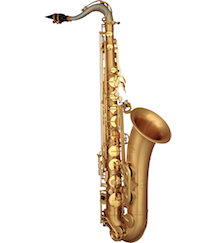September 11, 2019
Inspiration and Invention of the Saxophone
Inspiration and Invention of the Saxophone
The saxophone is a relatively new instrument that was invented during the 1840s and patented in 1846 by Adolphe Sax, a Belgian musician and instrument maker. A member of the woodwind family, saxophones are usually made of brass, and are played with a single reed mouthpiece, similar to that of the clarinet. The sax is used in many genres of music including classical, military and marching bands, jazz, and contemporary music, including rock and roll.
As a youth, Adolphe Sax studied the flute and clarinet at Brussels Conservatory of Music. His father was a musical instrument maker and Adolphe apprenticed in the shop, where he was gi

Sax’s concept of the saxophone family was quite a bit wider than just one instrument. His 1846 patent described 14 different versions of the saxophone in two groups, ranging from F contrabass all the way up to Eb sopranino. The series pitched in Bb and Eb soon became dominant and most of today’s saxophones are from this series.
Saxophone Manufacturers Then and Now
Sax’s patent expired in 1866, enabling other instrument manufacturers to build new versions of the saxophone. Early interest in the saxophone waned in Europe from 1870 to 1890, but it was steadily gaining in the United States as new musical styles became popular. Vaudeville and ragtime laid the groundwork for dance orchestras and eventually jazz, greatly expanding the demand for saxophones. In the 1890s, C.G. Conn, a respected manufacturer of brass instruments, began production of saxophones in the United States, providing a much more reliable and available supply of the instruments.
The modern layout of the saxophone emerged during the 1930s and 1940s, first with right-side bell keys introduced by C. G. Conn on baritones, then by King on altos and tenors. In 1936, Selmer revolutionized the mechanics of the left hand table with their Balanced Action instruments, capitalizing on the right-side bell key layout. In 1948, Selmer introduced their Super Action models with right and left hand stack keys offset about 30 degrees apart, allowing for a more relaxed pose and greater dexterity on the keys. Selmer’s layout became the new standard and was adopted for virtually every saxophone being produced, from student to professional models.
Selmer’s Mark VI saxophones, manufactured from 1954 to 1974, are legendary. The horns are known for their tone and mechanical excellence, but music historians believe other factors contributed to the success of the Mark VI. United States production of saxophones dropped during World War II because of the rationing of many metals, including copper and zinc, which make brass. Musicians seeking professional quality instruments turned to the more readily available Selmer saxophones. The Mark VI’s allure was also enhanced by its production run that coincided almost perfectly with the golden era of modern jazz. Selmer produced between 150,000 and 200,000 Mark VI’s, most of which are still in circulation. Price tags for this model are hefty, typically $10,000 or more.
5 Famous Sax Players and Their Instruments
Although the saxophone was invented for orchestral music, the most widely recognized saxophonists came from the world of jazz. The following are five of the greatest saxophone players the world has known:
Charlie Parker is often cited as the greatest saxophone player in history. He elevated jazz from entertaining dance music to the highest form of spontaneous artistic expression. Charlie favored the alto sax, playing on Conn M series instruments, Martin, Grafton, and eventually Selmer.
John Coltrane established himself as his generation’s greatest virtuoso of the tenor sax through his work with Miles Davis and Thelonious Monk. Coltrane favored the Selmer Mark VI tenor saxophone.
Sonny Rollins, a jazz tenor saxophonist, is widely recognized as one of the most important and influential jazz musicians the world has known. Rollins has been called the greatest living improviser and the “Saxophone Colossus”. His preferred sax is the Selmer Mark VI.
Lester Young rose to prominence while a member of Count Basie’s orchestra. He played tenor sax and occasionally the clarinet. Young played with a relaxed, cool tone using sophisticated harmonies. He is also credited with inventing and popularizing some of the jargon that came to be associated with jazz. Young played a Conn M sax during much of his career.
Stan Getz may be second only to Coltrane as the name most synonymous with the saxophone. He played tenor sax and modeled his playing style after Lester Young, who was his idol. Getz may be best known for introducing bossa nova to American audiences and for his Grammy award winning “Girl from Ipanema.” He played the Selmer Mark VI tenor saxophone.







